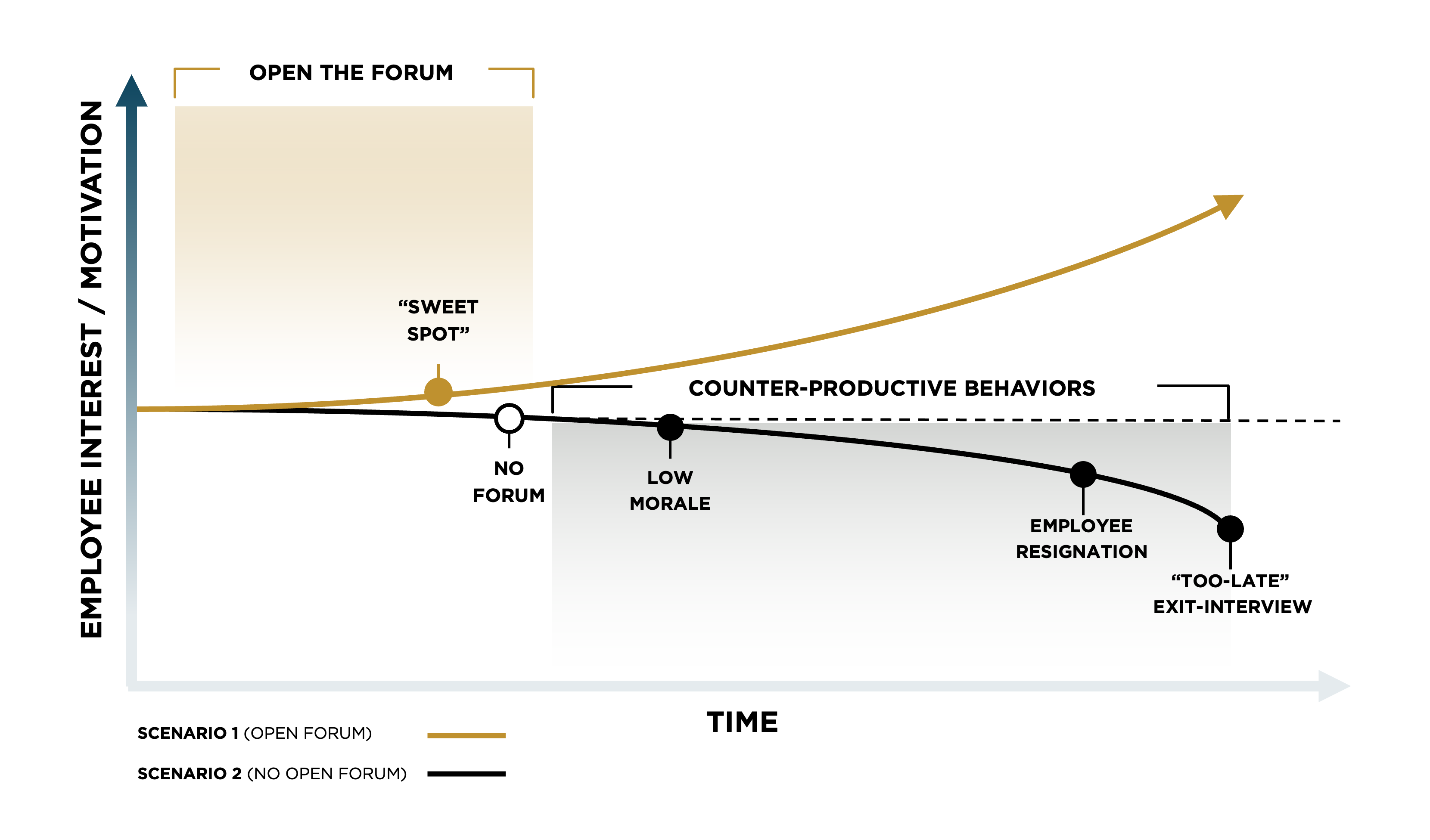The modern workplace is going through a historic transformation, with the impacts and importance of employee experience coming into clear focus. After a very reactionary period, organizations need to rethink their employee experience strategy and thoughtfully center it around what their employees actually want.
Current conversations regarding employee needs have shifted beyond just pay and benefits. Employees want to feel connected to their workplace and are seeking opportunities that offer not only pay parity, fairness, and security, but also invest in continuous growth, give greater flexibility and choice, and have a positive culture that nourishes both professional and personal needs. When organizations fulfill these deeper needs and connections, it generates the stickiness organizations need in a competitive talent marketplace: a greater sense of loyalty, positive employee engagement, and long-term retention.
“80% of employees consider leaving when they feel a disconnect between their work and the overall company goals.” – Cascade 2022 Strategy Report
Unfortunately, there’s often a disconnect between what leaders think employees want and what they’re actually asking for. The symptoms of a lack of action (or the wrong action) are low morale, reduced energy, discontent, decreased productivity, and high attrition. Historically, capturing the voice of the employee has often been a reactionary response. For example, only when an employee files their resignation does an organization spend time in an exit interview to learn why they are leaving and how the organization might need to change.
Interest/Motivation & Counter-productive Behaviors

To overcome these barriers, and truly capture the voice of the employee, you need early and consistent communication. Once you open that door, it becomes easier to tap into employee pain points and use their voice as a guide for change.
“Emotions matter. Identify and manage the moments that matter to employees.” - Gartner
For organizations to grow and develop, they need to harness the employee voice to cultivate change. Below we share a four-step framework that taps into the pulse of employees and embeds their voices in the process. This framework puts the focus on employees and leverages them to redefine the problem through multiple perspectives (outsmart biases!). It ensures early buy-in by being inclusive of stakeholders, puts employees in the driver’s seat to explore and co-create change, and activates and moves the change forward. With this framework as your guide, you’ll enable your organization to create a solid employee experience that can weather any change or transformation.
Whether you’re embarking on a new transformation program or halfway through, this approach and the voice of the employee can be leveraged at any point in the process. The only thing worse than not considering these at the start or halfway through is not considering them at all!
# A 4-Step Framework to Tap Into the Voice of the Employee
1 | Explore and Empathize
Get to know your audience, listen, and engage.
Move away from the problem. While it may sound counterintuitive, it is necessary. Time and effort should be spent understanding and defining the problem before you jump to finding a solution. Where are employee friction points? Is everyone experiencing the same issue or is it different for different types of employees? Begin by gathering these insights to generate direction and belonging.
In Action
- Create an empowered cross-functional employee forum. Use this forum to initiate meaningful dialogue and discover from people what might need to change.
- Use an empathy map to look at the wide range of stakeholders and map their emotions about the issue.
2 | Define and Ideate
Define the problem, clarify expectations, and ideate.
Now that you understand your employees’ pain points and perspectives, you can begin to define the problem. Create employee personas and groups that represent the needs and motivations of your employee landscape as well as identify their aptitude for change. Understand who and how different employee personas/groups are impacted. Clarifying expectations is a must. Connect the problem to the cause and purpose of the organization and utilize this as a ‘North Star’ moving forward.
In Action
- Utilize these personas to aid with the decision-making process. Personas will help users understand diverse perspectives and encourage collaboration.
- Use the employee voice inputs to define key design principles to aid decision-making and to anchor you to your North Star.
- Devise a future state experience map to help stakeholders visualize where the issue/initiative/organization is headed and how it might impact their day-to-day. Highlight what the experience will look and feel like for employees.
3 | Connect and Experiment
Build close alignment between organizational values and the voice of employees.
Work on making employees feel that they are a part of the overall vision — the Big Picture — by co-creating solutions. Communicate actively to maintain the feedback loop that you just tapped into and show employees that their voice truly matters.
In Action
- Strengthen the link to organizational outcomes by clearly anchoring chosen initiatives and actions to your learnings.
- Use storytelling to provide your team with a stable foundation and reassurance. Authentically communicate about the impact of the work and emphasize improvements to exhibit employee co-creation and ownership.
- Demonstrate insight to action – show how the design principles are reflected in the approach and outputs. Leverage the employee group as the dedicated representative tool to experiment, test, and learn in small cycles to validate your initiative and create change options.
4 | Socialize and Mature
Socialize initiatives early on to kick-start the collaboration process.
While you may not always be able to share specifics of initiatives with employees, you can in most cases share the high-level strategy. Make employees feel heard and taken seriously by engaging them early on and repeating the high-level plan in as many settings as possible. Employee input is the foundation for your case for change. Be sure to share details using language that resonates with them. At the same time, keep actively listening to their feedback in the forum. This will help leaders iterate early and save time, energy, and resources.
In Action
- Leverage a communication cascade to enable the information to flow from the top to the bottom. Use people managers and influencers as your change enablers to spread positivity and build momentum for what’s coming.
- Train sponsors to have one-on-one conversations, if necessary, by providing them with the tools (tips and planners) required to drive the change forward.
- Continue to share ongoing progress and recognize and celebrate wins (even small ones).
- Allow your strategy to evolve organically as learnings are gathered, employee participation continues and grows, and your understanding deepens.

# Food for thought
The wheels behind the framework use tools and strategies from the playbooks of Change Management and Design Thinking.
Design thinking at its core is a solution-based approach that seeks to understand the end-user experience and redefine problems to capture the various lived experiences. It has a strong focus on exploration, leading with ambiguity and purposely looking beyond the surface level. If used properly, it reduces the risks associated with introducing new initiatives and helps with building meaningful moments that truly resonate with the voice of employees.
Alongside it, a strong change management strategy helps enable organizations to successfully achieve a desired future state. It aids in driving alignment and encouraging the adoption of whatever initiative you take on. It is a thorough lens that helps bring employee awareness and understanding at each juncture of the change journey, involves them in the solution, and allows leaders to think through the risks, the desired outcomes, and the end-to-end strategy.
The cross-collaboration of these two approaches ensures early buy-in through co-creation and the long-term viability of initiatives by placing employees at the center of your strategy.
Related Content: Designing Change: Applying Design Thinking to Change Management
# Wrapping It Up
Before you jumpstart your search for capturing the voice of your employees, remember that this is an ongoing process. Refine your strategy over time and keep listening to your employee’s evolving needs. Every organization is different, and every culture has its unique requirements. This is the beauty of the voice of the employee approach: it’s flexible, iterative, and inclusive.
Special thanks to Architaa Kasera for her help in the content development of this piece.





